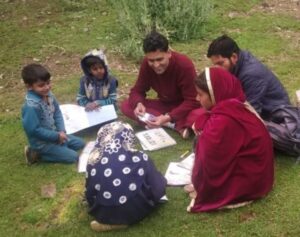In a rural classroom with no toys or tech, nature became the greatest teacher of all.
In the ever-evolving landscape of early childhood education, where capturing the imagination of young learners is both an art and a science, educators are constantly in search of innovative strategies to spark curiosity and sustain engagement. My own journey toward such a discovery began in the most unexpected of places—not within the walls of a classroom or among educational tools, but in the quiet simplicity of nature.
This path was shaped by a deeply personal realization: many of my kindergarten students came from economically disadvantaged backgrounds. In their homes, the presence of toys, storybooks, and structured learning materials was often a luxury rather than a norm. Yet, even in the midst of these limitations, there existed an abundant, overlooked resource—one that required no purchase, no packaging, and no electricity: the natural world.
The spark for this realization came during a serene evening walk through a nearby paddy field with my young daughter, Toiba. As we wandered beneath the amber sky, we stumbled upon a fledgling breasted crake, nestled shyly among the stalks. Toiba, her eyes wide with wonder, was instantly captivated. She insisted we find the bird’s mother, a request that I couldn’t fulfill—but one that lingered in my thoughts.
Later that night, still stirred by our encounter, I found myself gathering leaves, twigs, and flower petals from our modest kitchen garden. Inspired by Toiba’s curiosity, I began to shape a small piece of art—a tender scene of a breasted crake feeding its chicks, assembled entirely from natural materials. When Toiba awoke and saw the finished piece, her delight was immediate and profound. That moment, simple yet powerful, convinced me that this idea had the potential to reach far beyond my own home.

The next day, I introduced the concept of leaf art to my kindergarten classroom. The impact was nothing short of transformative. Children who had been irregular in attendance began showing up eagerly each day. Their eyes sparkled with the same curiosity I had seen in my daughter. They spent hours in their gardens or on school grounds, gathering leaves of all shapes and sizes, crafting animals, birds, letters, and numbers. As they arranged the pieces, they discovered names, colors, textures, and the subtle variations of the natural world around them.
Soon, the classroom was alive with creativity. Letters and numbers emerged not from textbooks, but from hands-on experimentation—meticulously arranged leaves shaped into alphabets and numerals. Our learning space became a vibrant menagerie, where butterflies, elephants, peacocks, and deer came to life through the fingers and imagination of children who had never owned a coloring book. Each leaf turned into a canvas, each creation a masterpiece born from pure, unstructured exploration.
What set this practice apart was not only its creativity but its radical accessibility. In an era dominated by commercial educational aids and plastic toys, leaf art offered a zero-cost alternative with limitless potential. It eliminated financial barriers, making learning democratic and inclusive. Every child—regardless of background—could participate, engage, and excel. Nature became the great equalizer.
Beyond aesthetics, leaf art cultivated deeper cognitive benefits. As students manipulated leaves into specific shapes and compositions, they were not just creating—they were reasoning, problem-solving, and developing spatial awareness. Conversations around the animals they made led to discussions about habitats, ecosystems, and conservation. In these exchanges, seeds of environmental awareness were quietly planted.
Leaf art became more than an activity—it became a pedagogical tool, a bridge between the world children lived in and the knowledge we aimed to impart. It aligned naturally with experiential learning models, offering children the opportunity to touch, see, arrange, and question. It gave them agency in their own education.
In the end, what began as a simple act of parental creativity evolved into a grassroots educational movement within my classroom. It redefined how we approached teaching, reminding us that sometimes, the most powerful tools are those closest to the earth. Through leaf art, we not only taught children to learn—we taught them to see, to wonder, and to believe that beauty and knowledge are often found in the most humble of places.

Leave a Reply